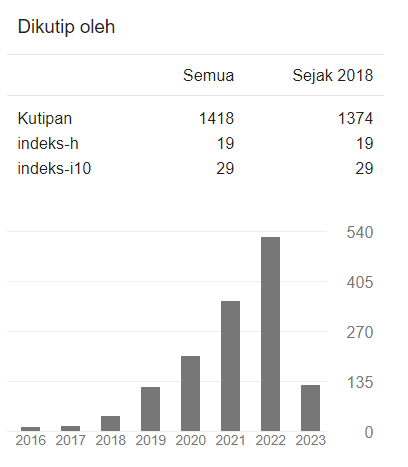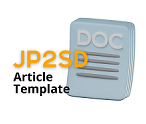Pengembangan Media Mibogi (Mistery Box Materi Energi) pada Pembelajaran IPAS Kelas IV Sekolah Dasar
DOI:
https://doi.org/10.22219/jp2sd.v12i2.34105Keywords:
media, pembelajaran IPAS, Kelas IVAbstract
Utilizing limited and monotonous learning resources might trigger a loss of willingness to learn for students, and the inappropriate use of learning media can also affect the quality of learning. Moreover, in IPAS learning, especially energy material, concrete learning media is required to support learning. This research aims to develop cube-shaped media that will be developed into Mibogi (Mystery Box Energy Material) media. In addition, Mibogi media will also be tested to determine the feasibility and validity of Mibogi media as a learning media for IPAS. The ADDIE model development is applied in this research, and the stages are carried out sequentially. Two data collection techniques are: 1) employ a qualitative methodology using needs analysis, interview, and improvement input from experts, and 2) employ a quantitative approach using data processing of questionnaire answers into percentage values. The percentage value of this media is declared practical and very feasible based on the percentage value of 83% material experts and 96% media experts. When the outcomes of expert validation state that Mibogi media is considered practical and very feasible, the effectiveness test is given to educators, and the percentage value obtained is 85% with very feasible criteria. Then, implementing Mibogi to students on a limited scale test obtained 98% results, and a broad scale test obtained 93% results. Both show that Mibogi media is the perfect learning media for learning IPAS energy transformation material. Mibogimedia is as practical and feasible as IPAS learning in grade IV.
Downloads
References
Al, P., Hidayatullah, A., Widana, W., Ketut, I., & Adnyana, S. (2022). Pengembangan Media JESSTAR Sebagai Media Pembelajaran Tematik Tema 9 Kelas VI SD. Jurnal Pemikiran Dan Pengembangan Sekolah Dasar (JP2SD), 10(1), 74–87. https://doi.org/10.22219/jp2sd
Alvi Nanda Choirina, Bintartik, L., & Utama, C. (2023). Pengembangan Booklet Materi Hubungan Antar Makhluk Hidup dalam Ekosistem dengan Penguatan Karakter Mandiri Siswa Sekolah Dasar. Jurnal Pemikiran Dan Pengembangan Sekolah Dasar (JP2SD), 11(2). https://doi.org/10.22219/jp2sd.v11i2.27613
Branch, R. (2009). Instructional Design: ADDIE Approach. Springer. https://doi.org/10.1007/978-0-387-09506-6
Ciptaningtyas, W., Mukmin, B. A., & Putri, K. E. (2022). E-Book Interaktif Berbasis Canva Sebagai Inovasi Sumber Belajar Materi Sistem Pencernaan Manusia Kelas V SD. Jurnal Pemikiran Dan Pengembangan Sekolah Dasar (JP2SD), 10(2), 160–174. https://doi.org/10.22219/jp2sd.v10i2.21788
Dewi Sartika, A., & Bahri, S. (2022). Pengembangan Media Magic Box Pada Pembelajaran IPA Di SD Negeri 105359 Sumberjo. Journal Ability : Journal of Education and Social Analysis, 3(1), 82–91. https://ummaspul.e-journal.id
Gustina Sari, S., Rahmayuni Jusar, I., & Wahyuni, S. (2024). Pengembangan Media Interaktif Berbasis Contextual Teaching and Learning pada Materi Bangun Datar Kelas IV Sekolah Dasar. Jurnal Pemikiran Dan Pengembangan Sekolah Dasar (JP2SD), 12(1), 14–27. https://doi.org/10.22219/jp2sd.v12i1.28312
Hadiyaningrum, N., Diyah, S. ’, & Wicaksono, V. D. (2022). Pengembangan Mistery Box Dalam Pembelajaran PPKN Materi Sejarah Perumusan Pancasila Untuk Siswa Kelas V Sekolah Dasar. JPGSD, 10. https://ejournal.unesa.ac.id/index.php/jurnal-penelitian-pgsd/article/view/48962
Harahap, O., Mastiur, & Novita. (2022). MEDIA PEMBELAJARAN Teori dan Prespektif Penggunaan Media Pembelajaran dalam Pembelajaran Bahasa Inggris (Safrinal, Ed.). CV. AZKA PUSTAKA.
Hasan, M., Milawati, Darodjat, Tuti, H., Tasdin, T., Ahmad, A., Masdiana, & I Made, I. (2021). Media Pembelajaran (U. Khasanah, Ed.; 1st ed.).
Heflita. (2019). 11 Kiat Pembelajaran Menyenangkan (R. Revisa, Ed.; Cetakan Pertama). CV. Insan Cendekia Mandiri.
Hetharion, B. (2023). Strategi Belajar Mengajar (Safrinal, Ed.; 1st ed.). CV. AZKA PUSTAKA.
Junaidi. (2019). Peran Media Pembelajaran Dalam Proses Belajar Mengajar. Jurnal Manajemen Pendidikan Dan Pelatihan, Vol. 3. https://doi.org/10.35446/diklatreview.v3i1.349
Karo-karo, I., & Rohani. (2018). Manfaat Media Pembelajaran. Axiom : Jurnal Pendidikan Dan Matematika, VII, 93–96. https://doi.org/http://dx.doi.org/10.30821/axiom.v7i1.1778
Meylovvia, D., & Julianto, A. (2023). Inovasi Pembelajaran IPAS pada Kurikulum Merdeka Belajar di SDN 25. Jurnal Pendidikan Islam AL-Affan, 4(Vol.4 No.1 (2023): Jurnal Pendidikan Islam Al-Affan), 84–91. http://ejournal.stit-alquraniyah.ac.id/index.php/jpia/
Nuryani, S., Hamdani Maula, L., & Khaleda Nurmeta, I. (2023). Implementasi Kurikulum Merdeka Dalam Pembelajaran IPAS Di Sekolah Dasar. Jurnal Pendidikan Dasar Flobamorata, 4(2), 599–603. https://e-journal.unmuhkupang.ac.id/index.php/jpdf
Paulina. (2022). Media Pembelajaran dan Kecerdasan Interpersonal Menilik Pengaruhnya dalam Pembelajaran Bahasa Inggris (A. Eldian, Ed.; Cetakan Pertama). CV BUDI UTAMA.
Prananda, G., & Wardana, A. (2020). Pengembangan Media Video Pembelajaran Tema 6 Subtema 2 Untuk Siswa Kelas SD Negeri 17 Pasar Masurai 1. Jurnal Dharma PGSD. http://ejournal.undhari.ac.id/index.php/judha
Pranata, K., Kartika, Y. W., & Zulherman, Z. (2021). Efektivitas Penggunaan Media Film Animasi Terhadap Peningkatan Keterampilan Menulis Cerita. Jurnal Basicedu, 5(3), 1271–1276. https://doi.org/10.31004/basicedu.v5i3.867
Pujilestari, Y., & Susila, A. (2020). Pemanfaatan Media Visual dalam Pembelajaran Pendidikan Pancasila dan Kewarganegaraan. Jurnal Ilmiah Mimbar Demokrasi, 19(02), 40–47. https://doi.org/10.21009/jimd.v19i02.14334
Putra, L. D., & Sentia, E. (2023). Pengembangan Modul Digital IPA Berbasis Contextual Teaching and Learning (CTL) untuk Siswa Kelas IV Sekolah Dasar. Jurnal Pemikiran Dan Pengembangan Sekolah Dasar (JP2SD), 11(2). https://doi.org/10.22219/jp2sd.v11i2.23049
Rachmawati Avivah, A., & Nadlif, A. (2023). Media Monopoli dalam Pembelajaran Hafalan Al-Qur’an Juz 30 pada Siswa Kelas V Sekolah Dasar. Jurnal Ilmiah Pendidikan Profesi Guru, 6, 529–539. https://doi.org/10.23887/jippg.v6i3.69306
Sa’adah, R., & Wahyu. (2020). METODDE PENELITIAN R&D (Research and Development) Kajian Teoritis dan Aplikatif (A. Abdullah, Ed.; 1st ed.). Literasi Nusantara.
Sugiyono. (2022). METODE PENELITIAN DAN PENGEMBANGAN (Reseach and Development/R&D) (S. Suryandari, Ed.; 5th ed.). ALFABETA,cv.
Suhelayanti, Syamsiah, rahmawati, I., Tantu, Y., Kunusa, W., Suleman, N., Nasbey, H., Tangio, J., & Anzelina, D. (2023). Pembelajaran Ilmu Pengetahuan Alam dan Sosial (IPAS) (R. Watrianthos & J. Simamata, Eds.; Cetakan 1, Vol. 1). Yayasan Kita Menulis.
Tafonao, T. (2018). Peranan Media Pembelajaran Dalam Meningkatkan Minat Belajar Mahasiswa. Jurnal Komunikasi Pendidikan, 2(2). https://doi.org/10.32585/jkp.v2i2.113
Wibowo, A., Rahman, A., Yus, A., & Simaremare, A. (2022). Analisis Efektifitas Media Pembelajaran PKN Terhadap Gaya Belajar Kelas III SD. In Journal of Educational Analytics (JEDA) (Vol. 1, Issue 1). https://journal.formosapublisher.org/index.php/jeda
Downloads
Published
Issue
Section
License
Copyright (c) 2024 yuni prastyaningsih

This work is licensed under a Creative Commons Attribution-ShareAlike 4.0 International License.
Authors who publish with Jurnal Pemikiran dan Pengembangan Sekolah Dasar (JP2SD) agree to the following terms:
- For all articles published in Jurnal Pemikiran dan Pengembangan Sekolah Dasar (JP2SD), copyright is retained by the authors. Authors give permission to the publisher to announce the work with conditions. When the manuscript is accepted for publication, the authors agree to automatic transfer of the publishing right to the publisher.
- Authors retain copyright and grant the journal right of first publication with the work simultaneously licensed under a Creative Commons Attribution-ShareAlike 4.0 International License that allows others to share the work with an acknowledgment of the work's authorship and initial publication in this journal.
- Authors are able to enter into separate, additional contractual arrangements for the non-exclusive distribution of the journal's published version of the work (e.g., post it to an institutional repository or publish it in a book), with an acknowledgment of its initial publication in this journal.
- Authors are permitted and encouraged to post their work online (e.g., in institutional repositories or on their website) prior to and during the submission process, as it can lead to productive exchanges, as well as earlier and greater citation of published work (See The Effect of Open Access).

This work is licensed under a Creative Commons Attribution-ShareAlike 4.0 International License.


















